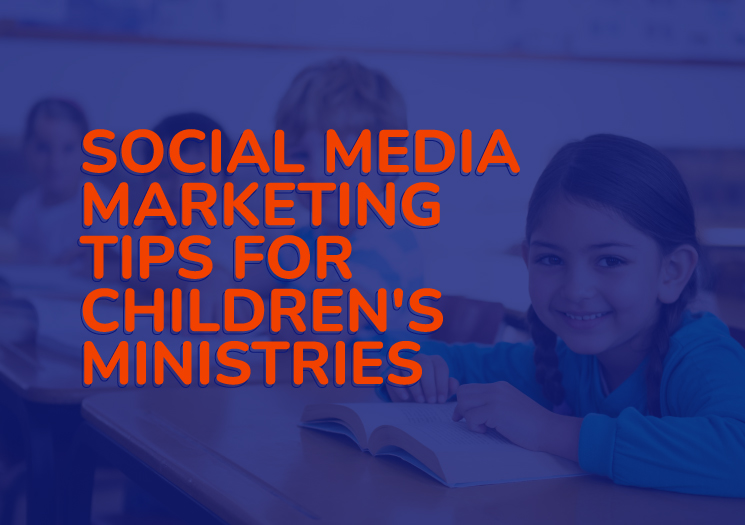3 Social Media Marketing Tips For Children’s Ministries

 Whether users are advocating for a nonprofit cause or generating excitement about a company’s newest product, social media marketing has been dubbed “an indispensable tool” in this digital age. But children’s ministry marketing feels like an outlier in this generalization, especially considering that most members of your ministry aren’t even old enough to create their own social media accounts.
Whether users are advocating for a nonprofit cause or generating excitement about a company’s newest product, social media marketing has been dubbed “an indispensable tool” in this digital age. But children’s ministry marketing feels like an outlier in this generalization, especially considering that most members of your ministry aren’t even old enough to create their own social media accounts.
The truth is, modern families—your primary audience—live on social media, and that’s where you need to meet them. With effective content and the right strategies, social media can become your ministry’s megaphone for sharing the real, genuine story of what God is doing among your kids and volunteers.
Let’s look at some of the most effective social media marketing strategies for your children’s ministry.
1. Define Your Social Media Audience
Identifying your audience enables you to determine the needs, hopes, and challenges that bring them to your page. Is your audience seeking guidance on sharing the gospel with their children? Or, perhaps their kids are already involved in your ministry, and parents follow your account to learn how they can best continue their Biblical education at home.
With this context, you can develop a communication plan that resonates with your followers. Focus your content on the people who are actually scrolling: parents or caregivers, other individuals in your church congregation, and community members.
Here are some considerations for each group:
- Parents or caregivers: The primary concern among parents and caregivers is their children’s well-being and spiritual development. Beyond logistical details (i.e., program times and locations), this group also wants to know that they can trust your ministry. They need reassurance that you understand their unique challenges and aspirations for their children, and they’re looking for signals of empathy and genuine care.
- Church congregation: Your church’s wider community wants to understand your ministry’s vision and impact. Some members may not have children, or their kids may not be part of your ministry, but they still want to see your efforts to nurture the next generation of believers. Congregation members may also be interested in opportunities for involvement, such as volunteering or providing financial support.
- Community members: Beyond reaching those already involved in the church, your ministry’s social media presence is also visible to the broader community. People actively seeking a spiritual home, as well as those who may not be believers yet, can stumble upon your content. Be mindful of how they may perceive your posts and view your content as an opportunity to make a positive first impression.
It’s worth noting that the children’s Bible curriculum your ministry uses should provide social media templates and communication tools that make it easy to engage with your followers. If you’re already using these resources, track engagement metrics (such as post likes, shares, or comments) to determine which content resonates more with your target audience. This data will set you up well for our next tip: content development.
2. Rotate Different Types of Content
Once you’ve narrowed down who you’re reaching, decide what types of messages you want to send to them.
Your ministry’s social media content should incorporate a variety of post types on a rotating basis to engage all followers. Let’s review the different types of content your overall marketing plan should include.
Spiritual Posts
Spiritual posts showcase the lessons your ministry teaches and their practical applications for daily life. For this content, you can pull information from your children’s church curriculum and mimic its teaching structure.
For example, each of Wonder Ink’s curriculum lessons is divided into four steps: Curiosity (hands-on activities), Belief (Bible reading), Faith (a conversation about the lesson), and Identity (a worship activity). A ministry using this curriculum could create educational, actionable social media posts based on these steps, as shown in the following examples:
- Weekly activity suggestion: Post a tutorial video every Monday that presents a fun craft or explains how to play a game based on the Sunday school lesson at home.
- “Bible verse of the week” post: Create an eye-catching graphic of a Bible verse or passage from the week’s Sunday school lesson. Encourage families to read the passage with their children and reflect on its meaning.
- “Big Question of the Week” graphic: A day after sharing Scripture for the week, post a thought-provoking question that helps families think deeply about the Bible verse or passage.
- Family worship challenge: Set a weekly worship goal for families and their children to complete at home, like praying every morning or making a list of 10 things they’re grateful for.
Leverage each social media platform’s tools to make lesson-based posts more engaging. Set up a poll on your Instagram or Facebook story where parents can answer questions like, “Where is your favorite place to worship?” Or, invite parents to tag your ministry’s account in videos of their families playing a Sunday school game, then repost the video.
Promotional Posts
Raising awareness of your ministry within the community provides an outlet to attract new families and, when appropriate, solicit support for your programs. Plan content that highlights your ministry’s exciting work and offers easy opportunities for viewers to get involved.
Here are some examples:
- A “Day in the Life of Our Ministry” video: Create a short video that provides a behind-the-scenes look at your children’s ministry sessions. Encourage community members to reach out if they’re interested in registering their children or visiting your church.
- Information about upcoming events and programs: Announce special events or initiatives and tailor these posts to specific audiences. For instance, potential event sponsors should know what supplies you’re looking for, while parents need instructions on how to register.
- Testimonials: Share quotes or short video testimonials from parents and children about their positive experiences in your ministry. Obtain parental permission anytime you’re filming or quoting children. If appropriate, include requests for financial or volunteer support along with testimonials.
If your team feels uncomfortable making specific requests for support on social media, consider listing your ministry’s needs on your website instead. This way, your social media posts can simply direct followers to your website for more information on how to pitch in, if they’re willing.
Appreciation Posts
Lesson-based content and community outreach both seek to gain audience participation. However, showing gratitude for your ministry’s community is equally important, making families, volunteers, and the community feel appreciated for their contributions!
Create social media posts solely dedicated to acknowledging your ministry’s community, such as:
- Children’s celebrations: Use photos or videos to highlight children’s participation in your ministry’s activities. Again, ask for parents’ permission before sharing any images of their children.
- Parent appreciation: Thank parents for their trust and support, emphasizing those who go above and beyond. For example, give a special shout-out to parents who donate snacks or assist with event planning.
- Volunteer spotlights: Feature a different volunteer each week or month with a photo and a brief caption about their service and what makes them special to the ministry.
Switch up the medium you use to suit the message you’re trying to convey. For example, an inspirational video of children praying might be more impactful for promoting your ministry, while a text-based post works best for marketing an event. Experiment with different formats and use engagement metrics to learn what resonates most with your audience.
3. Make Your Message Memorable
When your ministry’s social media followers encounter your posts, they should be able to identify a clear takeaway. Otherwise, they might scroll right past your content when it shows up on their feed next. Include a direct instruction or thought-provoking prompt in each post to keep your audience engaged.
Also, thoughtfully schedule your posts to avoid overwhelming followers with too much content. According to Getting Attention’s roundup of marketing statistics, the average number of times organizations post each week differs across social media platforms as follows:
- Facebook: 5.95 times per week
- Instagram: 4.9 times per week
- X (formerly Twitter): 6.97 times per week
- TikTok: 1.59 times per week
When in doubt, think back to what you know about your target audience. If the post doesn’t provide value to parents, the congregation, or the community, rethink whether it’s really worth sharing.
Every ministry’s marketing content will differ according to its unique audience and priorities. With thoughtful planning, your ministry can develop a social media strategy tailored to its needs and amplify its impact.


